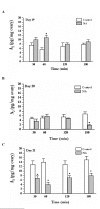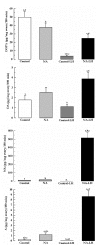The celiac ganglion modulates LH-induced inhibition of androstenedione release in late pregnant rat ovaries
- PMID: 17184551
- PMCID: PMC1769501
- DOI: 10.1186/1477-7827-4-66
The celiac ganglion modulates LH-induced inhibition of androstenedione release in late pregnant rat ovaries
Abstract
Background: Although the control of ovarian production of steroid hormones is mainly of endocrine nature, there is increasing evidence that the nervous system also influences ovarian steroidogenic output. The purpose of this work was to study whether the celiac ganglion modulates, via the superior ovarian nerve, the anti-steroidogenic effect of LH in the rat ovary. Using mid- and late-pregnant rats, we set up to study: 1) the influence of the noradrenergic stimulation of the celiac ganglion on the ovarian production of the luteotropic hormone androstenedione; 2) the modulatory effect of noradrenaline at the celiac ganglion on the anti-steroidogenic effect of LH in the ovary; and 3) the involvement of catecholaminergic neurotransmitters released in the ovary upon the combination of noradrenergic stimulation of the celiac ganglion and LH treatment of the ovary.
Methods: The ex vivo celiac ganglion-superior ovarian nerve-ovary integrated system was used. This model allows studying in vitro how direct neural connections from the celiac ganglion regulate ovarian steroidogenic output. The system was incubated in buffer solution with the ganglion and the ovary located in different compartments and linked by the superior ovarian nerve. Three experiments were designed with the addition of: 1) noradrenaline in the ganglion compartment; 2) LH in the ovarian compartment; and 3) noradrenaline and LH in the ganglion and ovarian compartments, respectively. Rats of 15, 19, 20 and 21 days of pregnancy were used, and, as an end point, the concentration of the luteotropic hormone androstenedione was measured in the ovarian compartment by RIA at various times of incubation. For some of the experimental paradigms the concentration of various catecholamines (dihydroxyphenylalanine, dopamine, noradrenaline and adrenaline) was also measured in the ovarian compartment by HPLC.
Results: The most relevant result concerning the action of noradrenaline in the celiac ganglion was found on day 21 of pregnancy resulting in the inhibition of androstenedione release from the ovarian compartment. In addition on day 15 of pregnancy, LH placed in the ovarian compartment led to an inhibition of the release of androstenedione, and this inhibitory effect was further reinforced by the joint action of noradrenaline in the celiac ganglion and LH in the ovary. The levels of catecholamines in the ovarian compartment showed differences among the experiments; of significance, the joint treatment of noradrenaline in the celiac ganglion and LH in the ovary resulted in a remarkable increase in the ovarian levels of noradrenaline and adrenaline when compared to the effect achieved by either one of the compounds added alone.
Conclusion: Our results demonstrate that the noradrenergic stimulation of the celiac ganglion reinforces the LH-induced inhibition of androstenedione production by the ovary of late pregnant rats, and that this effect is associated with marked changes in the release of catecholamines in the ovary.
Figures




Similar articles
-
The cholinergic influence on the mesenteric ganglion affects the liberation of ovarian steroids and nitric oxide in oestrus day rats: characterization of an ex vivo system.J Endocrinol. 2006 Dec;191(3):587-98. doi: 10.1677/joe.1.06859. J Endocrinol. 2006. PMID: 17170216
-
Norepinephrine modulates the effect of neuropeptides in coeliac ganglion on ovarian hormones release: its relationship with ovarian nitric oxide and nerve growth factor.Neuro Endocrinol Lett. 2010;31(1):103-12. Neuro Endocrinol Lett. 2010. PMID: 20150881
-
Androgen receptors in coeliac ganglion in late pregnant rat.Steroids. 2009 Jun;74(6):526-34. doi: 10.1016/j.steroids.2009.01.009. Epub 2009 Feb 21. Steroids. 2009. PMID: 19428441
-
The influence of chicken luteinizing hormone on radioactive phosphorus uptake and incorporation into pullet ovarian RNA, DNA, protein, phospholipid and acid-soluble fractions (chicken LH effects on the ovary).Comp Biochem Physiol. 1970 Aug 15;35(4):867-72. doi: 10.1016/0010-406x(70)90081-2. Comp Biochem Physiol. 1970. PMID: 4916386 Review. No abstract available.
-
Immunological approaches to fertility regulation in domestic livestock.Immunol Cell Biol. 1993 Oct;71 ( Pt 5):489-99. doi: 10.1038/icb.1993.54. Immunol Cell Biol. 1993. PMID: 8270276 Review.
Cited by
-
In Adult Rats With Polycystic Ovarian Syndrome, Unilateral or Bilateral Vagotomy Modifies the Noradrenergic Concentration in the Ovaries and the Celiac Superior Mesenteric Ganglia in Different Ways.Front Physiol. 2019 Oct 22;10:1309. doi: 10.3389/fphys.2019.01309. eCollection 2019. Front Physiol. 2019. PMID: 31695622 Free PMC article.
References
-
- Erickson GF, Magoffin DA, Dyer CA, Hofeditz C. The ovarian androgen producing cells: a review of structure/function relationships. Endocr Rev. 1985;6:371–399. - PubMed
-
- Dissen GA, Ojeda SR. Ovarian innervation. In: E K, Neill J, editor. Encyclopedia of reproduction. New York: Academic Press; 1999. pp. 583–589.
Publication types
MeSH terms
Substances
LinkOut - more resources
Full Text Sources

